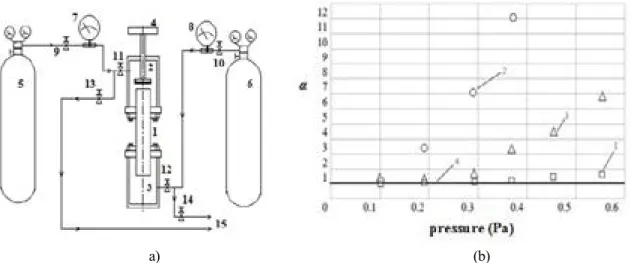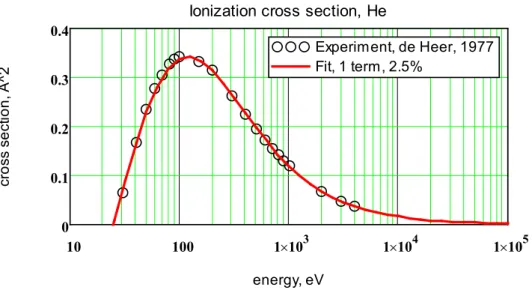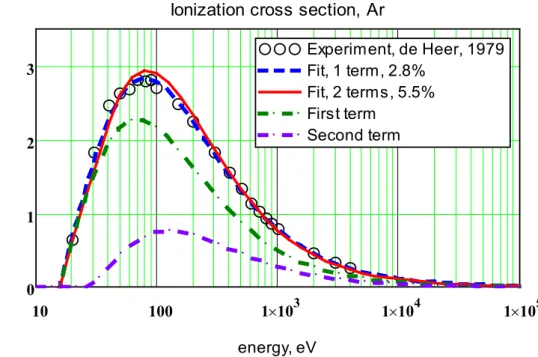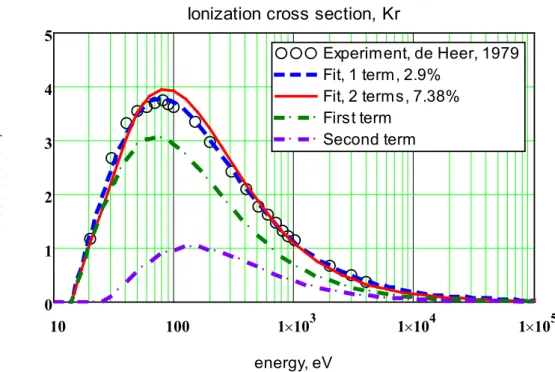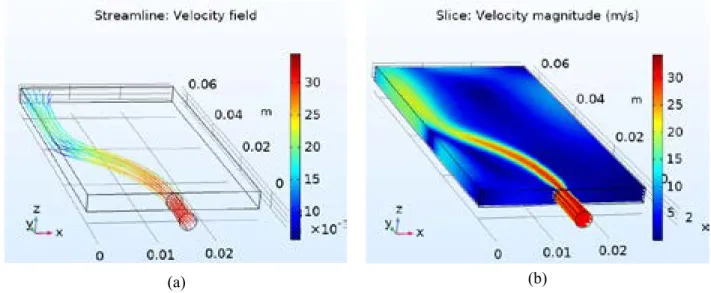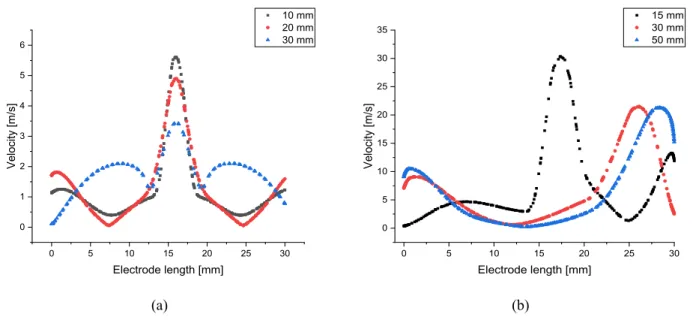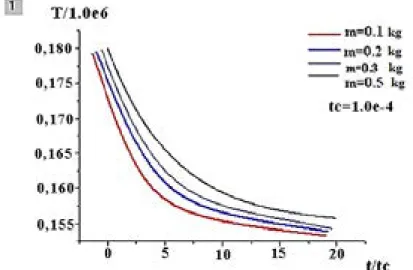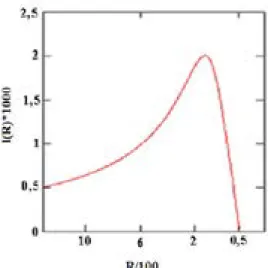From the one-term and two-term analytical dependences, the approximation errors and the coefficients of the ionization cross sections of the noble gas atoms were obtained. The energy dependence of the ionization cross section for an electron collision with noble gas atoms was calculated and compared with available experimental data. And in experiments it is the maximum value of the ionization cross section that is most accurately measured.
Approximation of the cross section in the binomial approximation leads to an insignificant. Approximating the cross section in the binomial approximation results in an increase of the relative error by 6.2%.
![Table 1 shows the characteristics of noble gas atoms from [26-27] and experimental data on the measurement of ionization cross sections from [28-30]: the symbol and number of the atom, the static polarizability coefficient of the atom K 0 , the first](https://thumb-ap.123doks.com/thumbv2/azdokorg/10611083.0/6.892.94.811.758.935/table-characteristics-experimental-measurement-ionization-sections-polarizability-coefficient.webp)
Effect of laminar and turbulent flow on the collective motion of plasma microdischarges at atmospheric pressure
When affected by the air flow [16-20], the microdischarges begin to move in the direction of the flow. From the observation of this phenomenon, it can be seen that depending on the flow speed, the microdischarge movement has a different character. It is known that there are three types of dynamic gas flow regimes, the differences between the regimes depend on the gas flow rate.
At the same time closer to the walls the flow velocity starts to decrease and reaches a peak near the side walls of the discharge cell. Influence of a barrier discharge on the gas dynamic parameters of the plasma jet formed by it// Applied Physics.
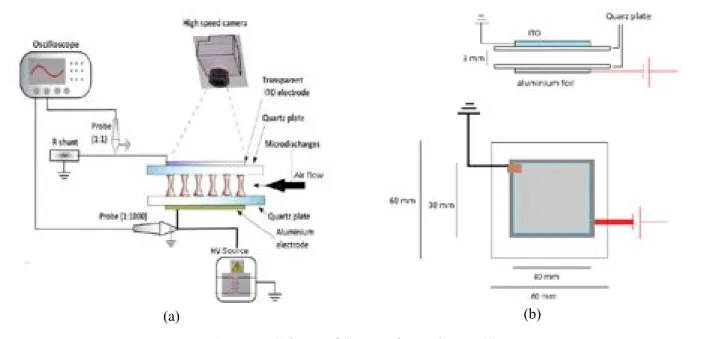
Modeling of solar flares like an electrical circuit in plasma focus devices
As a result, the free magnetic energy is released, which contributes to the flare-up process – the 'expansion' of the plasma. 𝑃𝑃𝑃𝑃 = 2 ∗ 𝜋𝜋𝜋𝜋�𝐿𝐿𝐿𝐿 ∗ 𝐶𝐶𝐶𝐶(𝐼𝐼𝐼𝐼) ≈ 10𝑙𝑙𝑙𝑙 𝐼𝐼𝐼𝐼11С (3) This last ratio makes it possible to estimate the magnitude of the electric current in the flash from the period of plasma oscillations. Figure 2 – The dependence of the plasma temperature in the flash model on the mass of the gas.
Figure 4 – Dependence of the velocity of the plasma clot on the pressure The value of the velocity increases in all cases. Based on the data obtained, the dependence of the plasma clot temperature on the speed of particles interacting with each other was modeled. As can be seen, the temperature output strongly depends on the velocity of the incoming particles.
Since the plasma focus is similar to an oscillating circuit, the scaling of the real flash and the size of the plasma focus was used to idealize the flash pattern in the setup. As a result, the dependence of the current power on the value of the resistance of the circuit is shown in figure 6. From here it is not difficult to get the value of the so-called coefficient of difference 65 * 105.
In addition, we compared the results obtained from solar activity from 2 to 4 November 2003, presented in Figure 9, part a, and the theoretical dependence of the current strength on the changing resistance in the plasma focus [16]. In that way, we can conclude that the physically conceptual model of the solar flare is "electrical circuit". Determination of the resistance of external parameters against the degradation of the parameters of silicon photocells.
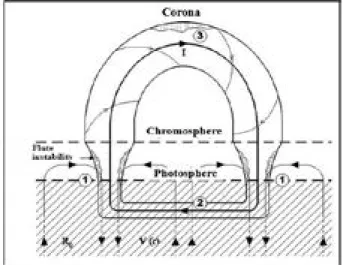
Determination of the resistance of external parameters to the degradation of the parameters of silicon photocells
3 Experimental results and their discussion The stability of the electrophysical parameters of the obtained photocells, when operated under experimental conditions such as elevated temperatures and. To elucidate the nature of the change in the electrophysical parameters of photocells based on silicon doped with impure nickel atoms in silicon, studies were carried out on the effect of additional thermal annealing on the open-circuit voltage and short-circuit current of control photocells. 18–20]. The study of the effect of additional annealing at high temperature after the formation of a p-n junction led to a decrease in the initial parameters of photocells.
Tables 1 and 2 show data on the change in the open-circuit voltage and short-circuit current of the control photocell depending on the temperature of thermal annealing at an annealing time of 1 hour. The study of the effect of additional heat treatment on the parameters of photocells with clusters of impurity nickel atoms at T = 600 and 650 °C for 3 hours showed that no practical changes were observed in the electrophysical parameters of photocells. After the formation of the p–n junction, a decrease in the parameters of additional heat-treated photocells was observed.
The study of the effect of γ-radiation was carried out in the range of radiation doses from 105 to 109 R/sec on the electrical parameters of silicon-based photocells. Figures 2 and 3 show the results of the study of the dependence of the short circuit current and the open circuit voltage on the dose of γ radiation. The dependence of the open circuit voltage of the photocells on the radiation dose γ is shown in figure 2.
During irradiation with a dose of up to 107 R, the change in the value of the open circuit voltage and the short circuit current was not higher than 1-2%. Based on the results of the obtained data, the following important conclusion can be made - the radiation stability of photocells additionally alloyed with nickel atoms improves the open circuit voltage and short circuit current by two to four times compared to the parameters of control photocells. made without admixture of nickel atoms. The effect of implantation of active metal ions on the elemental and chemical composition of the CdTe surface // Technical physics.
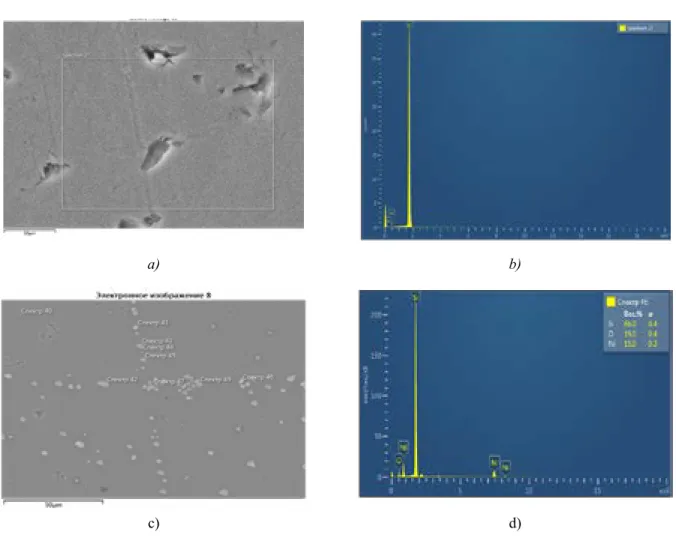
The effect of deposition technique on formation of transparent conductive coatings of SnO 2
The formation of the sol and its transition to a gel occurred on the surface of the substrate. The structure of the films was determined by X-ray diffraction analysis on a DRON-6 diffractometer. Table 1 shows that the thickness of the films varies from 250 nm to 290 nm.
The surface tension of the film-forming system N/m, the contact angle of the system "glass substrate / film-forming system" (θ) tends to zero. In this, on the upper part of the sample, the evaporation of the solvent and the course of reaction (1) lead to the formation of solid phase of Sn(OH)4 (sol) and its structuring (gel). Under the influence of centrifugal forces, part of the film-forming system "flies away" from the surface of the substrate.
Contact with a hot substrate causes the evaporation of the solvent and the course of reactions (1) and (2). Based on the available interference peaks, the parameters of the films were calculated using the envelope method [19]. This discrepancy is due to the difference between the density of the films and the density of cassiterite.
The resistance of the films was determined by 10 measurements on different parts of the samples. From Table 3 it can be seen that the resistance of the films deposited by dip and spin coating are close. Influence of precursor concentration on morphological and structural properties of zinc oxide (ZnO) // Chemistry and physics of materials.

Features of structural-phase states of Co-Cr-Al-Y composite coatings after heat treatment
A scratch was applied to the substrate at the back of the sample with a scraper (Fine Point Diamond Scriber 54467, Ted Pella, USA). Due to the low intensity of the peaks, the initial signal was approximated by Gaussian curves. The heat treatment of the coatings was carried out on a MILA-5000 unit (ULVAC-RICO (Japan),.
The study of the structure and composition of multilayer coatings was carried out using the electron microscope. Elemental mapping by constituent elements showed that with a relatively uniform distribution of Al and Y in the coating thickness, the enriched/depleted Co layers/. A large amount of Y in the substrate during elemental mapping is associated with the overlap of Y and Si spectra in the EDS spectrum.
The presence of oxygen in the surface layer of the coatings is due to its adsorption on the cutting surface after removal from the vacuum chamber, as well as after etching with argon. The formation of intermetallic compounds in the deposited Co-Cr-Al-Y system was not detected. а) b) Figure 3 – TEM images of the cross-section of the coating (a). The structure of the samples, as well as that of the unannealed samples, is columnar, the same microcracks are observed as in the unannealed samples.
As noted above, the presence of oxygen in the surface layer of the coatings is due to its adsorption on the cutting surface after removal from the vacuum chamber. Elemental mapping through constituent elements showed a relatively uniform distribution of Al and Y in the coating thickness and layers of enriched/depleted Co/Cr alternate. A large amount of Y in the substrate during elemental mapping is associated with the superposition of the spectra of Y and Si in the EDS spectrum.
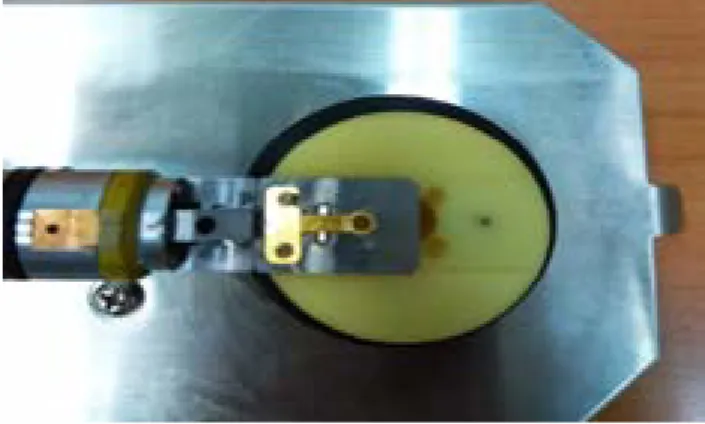
Instability of mechanical equilibrium and some features of concentration convection in isothermal ternary gaseous systems
The order of the components in the studied mixture is indicated by the amount in parentheses. In order to rule out convective mechanisms caused by the unstable density stratification of the system [1-5], a lighter (in terms of density) binary mixture was placed above the heavy gas. Analysis of the data presented in this figure shows that in the pressure range up to 0.15 MPa, diffusion occurs in the system.
The increase in the speed of the formation of convective currents is related to the subsequent increase in pressure. The weighted average and numerical average velocity have perturbations of the same order of magnitude. The numerical solution of the system of equations (4) is based on the use of the splitting method by physical quantities [20].
The problem is modeled in a rectangular coordinate system in which a two-dimensional area of cylindrical cross-section with dimensions H × d is assigned. The pressure field is determined from the resulting intermediate velocity field using the Fourier method. The final calculation of the velocity field is made assuming that the pressure gradient is the only cause of the transfer.
The mixture located at the top of the diffusion channel has a density less than the density of argon located at the bottom. This behavior of Freon-12 concentration on pressure indicates an intensification of the convective flow rate. Diffusion mechanisms for occurrence of instability of mechanical equilibrium in a ternary gas mixture containing carbon dioxide // Fluids.
